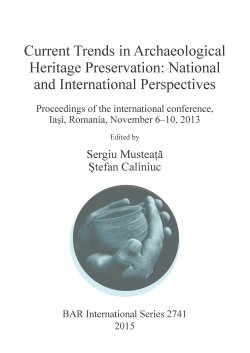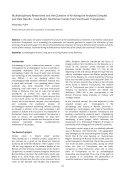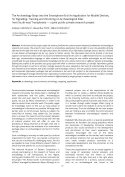Two new publications as results of the project

We were recently announced that the volume „Current Trends in Archaeological Heritage Preservation: National and International Perspectives. Proceedings of the international Conference, Iași, Romania, November 6–10, 2013” has been published. The results of our project, „The Eastern Border of Roman Dacia” are presented in two separate studies.
Our participation at this international conference, as well as the publication of the studies we presented speak for themselves, reflecting the fruitful cooperation with the colleagues from the Archaeology Institute of the Romanian Academy, especially with those involved in the CNCS UEFISCDI PN-II-ID-PCE-2011-3-0610 exploratory research project.
The first study presents the state of the researches within „The Eastern Border of Roman Dacia” project. The author analyses the structure of the multidisciplinary researches conducted in the roman camps in south-east Transylvania. He discusses the actual state of Romania regarding long term archiving of the results of the multidisciplinary researches, used for enhancing archaeological researches.

 The second study starts from the need to facilitate the communication between fundamental archaeological research and society. This micro-project's main result is a smartphone application that will offer its user the possibility of being informed at the right time and in the right place about the existence of an information package about a Dacian, a Roman or Late Roman archaeological site for e.g., found in his/her vicinity. The information that will be framed in the local, regional and national context will be structured and delivered towards the users in a differentiated manner, according to their age, communication language or other essential criteria. By using the new mobile technologies we will shorten considerably the way between fundamental knowledge and the user, whose interest lay in different aspects of knowledge. Defining the profiles of the possible user groups will allow a coherent transmission of scientific information, as well as its intrinsic message towards the users, adapted to their level of understanding, this being one essential socio-humanistic side of the scientific and technologic research. The new product and its connected services will incorporate information packages that will contribute to the user’s life comfort, to the improvement of the cultural and archaeological heritage administrative organizations’ performances. The application will serve to transform scientific information into a cultural one and it will transmit it differentiated by target groups to modern society.
The second study starts from the need to facilitate the communication between fundamental archaeological research and society. This micro-project's main result is a smartphone application that will offer its user the possibility of being informed at the right time and in the right place about the existence of an information package about a Dacian, a Roman or Late Roman archaeological site for e.g., found in his/her vicinity. The information that will be framed in the local, regional and national context will be structured and delivered towards the users in a differentiated manner, according to their age, communication language or other essential criteria. By using the new mobile technologies we will shorten considerably the way between fundamental knowledge and the user, whose interest lay in different aspects of knowledge. Defining the profiles of the possible user groups will allow a coherent transmission of scientific information, as well as its intrinsic message towards the users, adapted to their level of understanding, this being one essential socio-humanistic side of the scientific and technologic research. The new product and its connected services will incorporate information packages that will contribute to the user’s life comfort, to the improvement of the cultural and archaeological heritage administrative organizations’ performances. The application will serve to transform scientific information into a cultural one and it will transmit it differentiated by target groups to modern society.